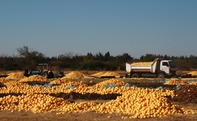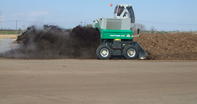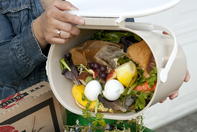Rich, well broken-down compost is an excellent soil conditioner. It adds organic matter as fuel for soil microbes, nutrients for the plant into the soil and it improves soil tilth - the physical condition of soil as a seedbed for planting.

What is Good Compost?
Good compost has a dark brown crumbly structure in which none of the raw materials (e.g. wood chips) are visible.
It will smell like soil or ‘forest floor’ and will have no pungent ammonia or rotten odour. It should have a pH of 7 - 8 and a moisture content of at least 30%; some experts even suggest 40 - 50%.
Benefits of Compost
Compost helps the soil to form aggregates. Aggregates are clumps of soil consisting of soil particles, organic matter and organic and mineral components. These soil aggregates contain pores where air and water molecules are stored and nutrients are exchanged.
Compost can help break up clay soil, increase soil aeration and reduces soil compaction.
Compost stimulates the production of beneficial soil bacteria and fungi. These soil microbes are essential to break down complex structures of organic matter in compost in order to release the nutrients stored inside organic matter.
Once the compost is completely broken down, humus, rich in fulvic and humic acids, is formed. These acids are the final break-down products of composting organic matter. Humic acids bind to insoluble nutrient compounds, especially iron, releasing them slowly and continually in forms that plants can absorb through their roots. These acids also convert nitrogen, phosphorus, potassium, zinc and other trace elements into plant-available forms and decrease high salt content in the soil.
How to Make Compost
Nearly any raw material can be used, provided it is properly handled and the optimum carbon: nitrogen ratio (C:N) is maintained, says Amigo Cantisano in his book Organic Farming: Principles and Practices.
The best carbon: nitrogen ratio or raw materials is 30:1. This means that the C:N of the combined raw materials should ideally be around 30:1. For example, the C:N of sawdust is 511:1 and the C:N of chicken manure is 7:1. Potentially this is a good combination, but the addition of other materials closer to a 30:1 (such as seaweed - 19:1 and wheat straw - 128:1) will ensure a more balanced combination of raw materials.
Use a diversity of raw materials. Hay, straw and chipped green waste improve the structure of a compost heap while fresh waste, animal manure and sea plants increase the microbial content of the compost.
Adding 10% of clay loam soil increases the crumb structure and rock dust also increases microbial activity. Do not add lime or gypsum until the compost is ready and ensure the compost heap is kept moist.
Composting in small gardens or households should follow the same rules when selecting raw materials for composting. Combine fresh fruit and vegetable waste with shredded paper and garden soil and mix well, sprinkling some water to ensure enough moisture for the breakdown process.
Types of Composting

Compost can be made through a hot or cold process. The hot process is more labour intensive as it involves regular turning of the compost pile to increase oxygen. Hot composting kills weed seeds and pathogens and speed up the composting process.
Cold composting involves a static compost heap, with raw material layers in a heap. This process can take over a year to complete, but adding an inoculum of starter microbes can boost the composting.
In static composting used for sewerage sludge, forced aeration or fans are used to increase oxygen in the compost heaps. Vermicomposting is the use of earthworms to breakdown organic wastes.
Materials for Compost

Carbon-rich raw materials which can be composted include nutshells, paper products, cardboard, straw, woodchips, sawdust, tea bags, cotton, fireplace ash, prunings, dried grass and leaves.
Nitrogen-rich compost materials include blood, hair and fur, animal manure, sewage waste, fresh grass and leaves, fresh fruit and vegetable waste, green cover crops, fresh weeds, seaweed, lawn clippings, etc.
Beware of materials that might attract flies and predators, especially in static, slow-composting heaps. Do not use meat scraps, coal or charcoal, pet waste, diseased plants, fats and oils.
Sewage waste and sludge may contain heavy metals and pathogens. Ensure finished compost is tested by a reputable laboratory before using it on edible crops.
By Marinda Louw